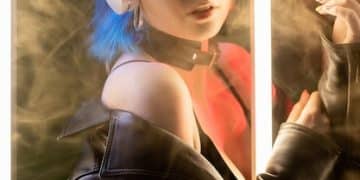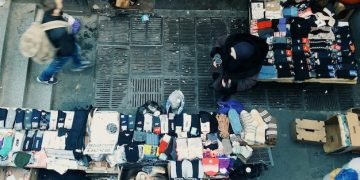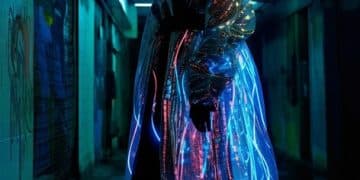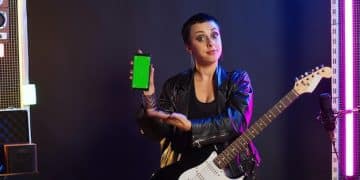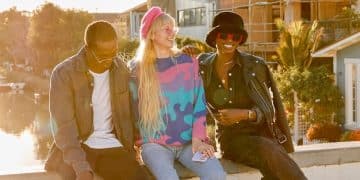Technology’s Impact: The US Alternative Art Scene in 2025
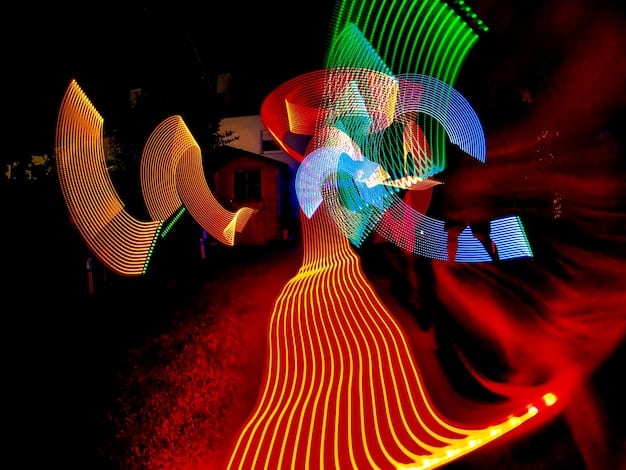
In 2025, technology profoundly shapes the US alternative art scene, fostering immersive experiences through VR/AR, democratizing creation with AI, revolutionizing distribution via NFTs, and building online communities, blurring the line between physical and digital realms and challenging traditional art paradigms.
The US alternative art scene, known for its innovation and boundary-pushing spirit, stands on the cusp of a technological revolution. How is technology shaping the US alternative art scene in 2025? It’s not just about digital art; it’s about how technology is interwoven into the very fabric of artistic creation, distribution, and community engagement, creating immersive and interactive experiences.
The Rise of Immersive Experiences
One of the most significant impacts of technology is the creation of immersive experiences that blur the boundaries between the physical and digital worlds. These experiences are transforming how audiences interact with art, making it more participatory and engaging.
Virtual and Augmented Reality Art
Virtual Reality (VR) and Augmented Reality (AR) are increasingly used to create art installations that transport viewers to entirely new worlds. Artists are using these technologies to craft interactive narratives, allowing audiences to explore and influence the artwork in real-time.
Interactive Installations
Beyond VR/AR, artists are employing sensors, projectors, and custom software to design installations that respond to the viewer’s movements or presence. These interactive pieces create a sense of co-creation, where the audience becomes an integral part of the artwork.
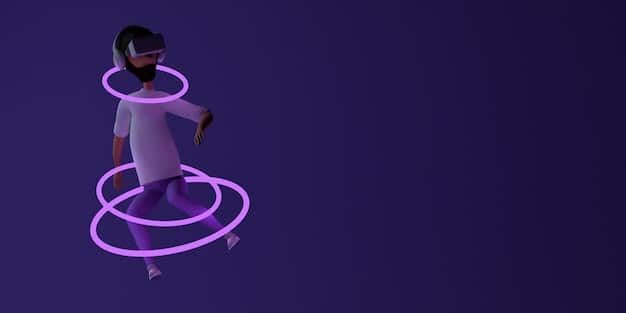
- VR/AR art installations offer unparalleled immersion, transporting viewers to new realms.
- Interactive installations engage audiences through movement and participation.
- These technologies blur the line between observer and creator.
- Artists use digital tools to craft dynamic and responsive artworks.
The convergence of technology and art enables creators to design experiences that are not just visually stunning but also deeply engaging, reshaping traditional notions of art consumption and participation.
AI as a Creative Partner
Artificial intelligence is no longer merely a tool but is emerging as a creative partner for artists. AI algorithms can generate novel forms of art, assist in the creative process, and even offer new perspectives on existing artistic styles.
AI-Generated Art
AI algorithms, trained on vast datasets of images, music, and text, can produce original artworks in various styles. These AI-generated pieces challenge our understanding of creativity and authorship, prompting us to reconsider the role of the artist.
AI-Assisted Creativity
Artists are also using AI to augment their creative process. AI tools can analyze patterns, suggest new ideas, and automate repetitive tasks, allowing artists to focus on the conceptual and emotional aspects of their work.
AI empowers artists with new tools and perspectives, fostering experimentation, and pushing the boundaries of art. This technology is not a replacement for human creativity, but rather an enhancement, opening new avenues for artistic expression and exploration.
The Democratization of Art Creation
One of the most profound ways technology is shaping the US alternative art scene is by democratizing art creation. Affordable and accessible tools have lowered the barrier to entry, enabling anyone to become an artist and share their work with the world.
Accessible Digital Tools
Software like Blender, Krita, and Audacity provide powerful digital tools for creating 3D art, digital painting, and music production, all without the high cost of traditional software. This empowers aspiring artists to develop their skills and create professional-quality work.
Online Learning Resources
Platforms like YouTube, Skillshare, and Coursera offer a wealth of tutorials and educational content that teach artists the skills they need to succeed. This democratizes art education, making it accessible to anyone with an internet connection.
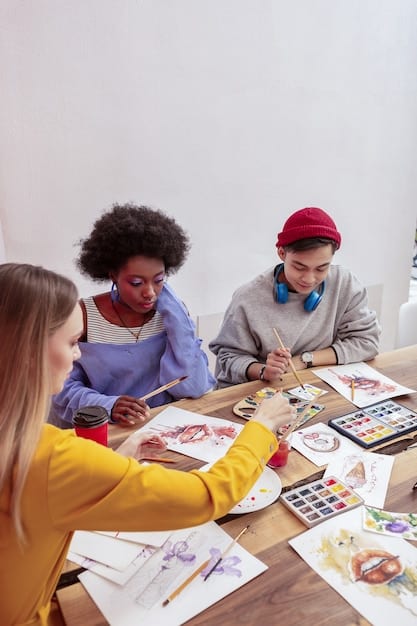
- Accessible digital tools lower the barrier to art creation.
- Online learning resources democratize art education.
- Anyone with a computer and internet connection can develop their artistic skills.
- This democratization fosters a more diverse and inclusive art scene.
The combination of accessible tools and online learning resources is fostering a more diverse and inclusive art scene, where anyone with passion and dedication can create and share their art.
NFTs and the Revolution in Art Distribution
Non-fungible tokens (NFTs) have revolutionized how alternative art is distributed and monetized. By providing a way to authenticate and sell digital artworks, NFTs have opened up new revenue streams for artists and collectors alike.
Direct Artist-to-Collector Relationships
NFT platforms enable artists to sell their work directly to collectors, bypassing traditional galleries and intermediaries. This allows artists to retain more control over their work and receive a larger share of the profits.
New Revenue Streams
NFTs also create new revenue streams through royalties. Artists can program their NFTs to receive a percentage of any future sales, ensuring that they continue to benefit from their work even after it is resold.
NFTs have transformed the art market by giving power back to the artists, allowing them to connect directly with collectors and earn a fair income from their creations.
Building Online Art Communities
Technology has facilitated the creation of online art communities where artists can connect, collaborate, and share their work. These communities provide support, inspiration, and opportunities for artists to grow and thrive.
Virtual Art Collectives
Platforms like Discord, Telegram, and Patreon enable artists to form virtual art collectives where they can share their work, receive feedback, and collaborate on projects. These collectives provide a sense of community and belonging for artists who may feel isolated in the physical world.
Online Galleries and Exhibitions
With online galleries and exhibitions, artists can showcase their work to a global audience, regardless of their location. These platforms provide new opportunities for artists to gain exposure and build a following.
Online art communities offer crucial support, collaboration, and opportunities for artists to thrive in a digital age. These communities are essential for fostering creativity, sharing knowledge, and building a sense of belonging among artists.
The Blurring Lines Between Physical and Digital Art
Finally, technology is blurring the lines between physical and digital art, leading to hybrid forms that combine elements of both. This convergence opens up new possibilities for artistic expression and challenges traditional definitions of art.
Projection Mapping on Physical Structures
Artists are using projection mapping to transform buildings, sculptures, and other physical structures into dynamic canvases for digital art. This creates stunning visual spectacles that blend the physical and digital worlds.
Interactive Digital Sculptures
Artists combine digital fabrication techniques, sensors, and microcontrollers to create interactive digital sculptures that respond to the viewer’s presence or actions. These sculptures bridge the gap between the physical and digital realms, inviting audiences to explore the interplay between them.
The fusion of physical and digital art creates new aesthetics and challenges conventional notions of art. These hybrid forms transform the way we experience and interact with art, leading to exciting developments in the alternative art scene.
| Key Topic | Brief Description |
|---|---|
| 🎨 Immersive Experiences | VR/AR and responsive installations redefine art engagement. |
| 🤖 AI as Creative Partner | AI generates art, assists creation, and offers fresh perspectives. |
| 🌐 Democratization of Art | Accessible tools and online education empower aspiring artists. |
| 💰 NFTs Revolutionize Distribution | NFTs enable direct artist-to-collector sales and revenue streams. |
FAQ
▼
VR/AR creates immersive environments, transporting viewers to new worlds within the artwork, allowing for interactive and deeply engaging experiences that transcend traditional mediums. Creating more captivating forms of art.
▼
AI serves as a creative partner, generating original art, assisting with brainstorming, and automating tasks, empowering artists to explore new creative territories and push artistic boundaries in innovative ways.
▼
NFTs enable direct artist-to-collector relationships, bypassing galleries and ensuring artists receive fair compensation. They also offer royalties on future sales, providing ongoing revenue streams for artists’ work.
▼
Online art communities offer support, collaboration opportunities, and a sense of belonging for artists. These platforms foster creativity, knowledge sharing, and networking, essential for thriving in the digital art scene.
▼
Artists blend physical and digital art using projection mapping on structures and creating interactive digital sculptures. This fusion challenges traditional definitions of art, fostering new aesthetics and immersive experiences.
Conclusion
As we look towards 2025, the integration of technology into the US alternative art scene promises to unlock unprecedented levels of creativity and innovation. With immersive experiences, AI-assisted creation, democratized access, and the revolutionary impact of NFTs, the future of alternative art is set to be more dynamic, accessible, and engaging than ever before.
